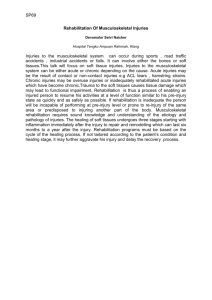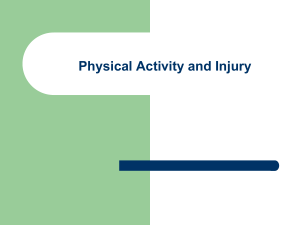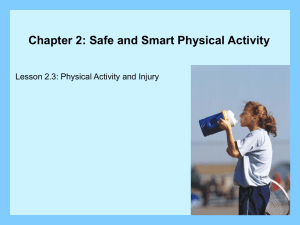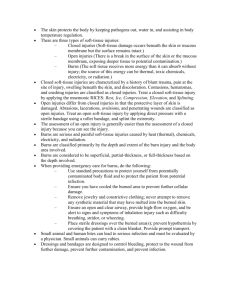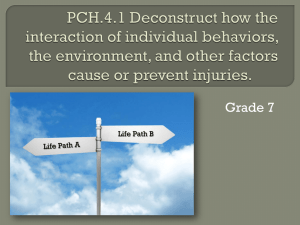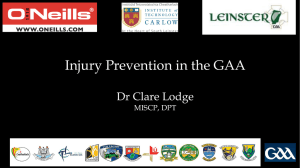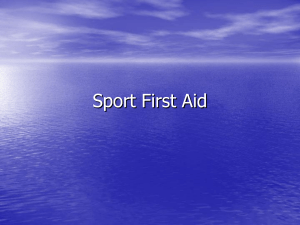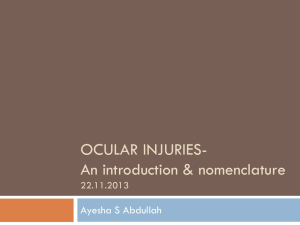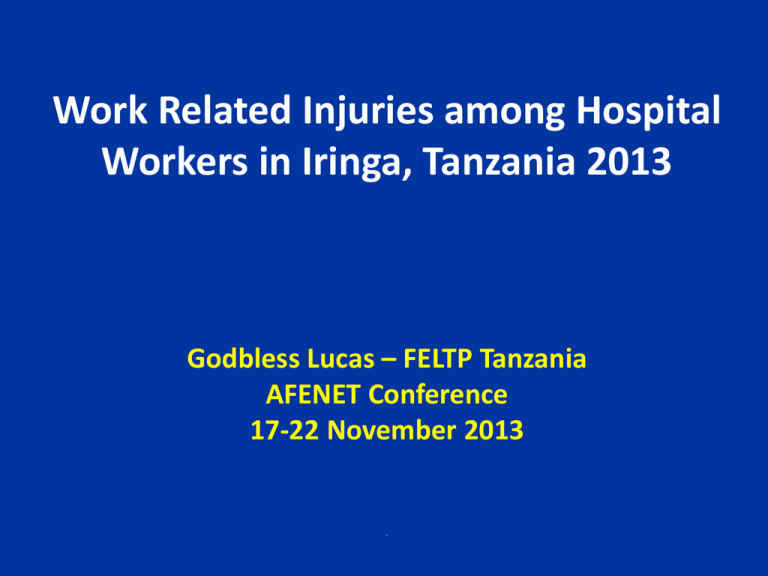
Work Related Injuries among Hospital
Workers in Iringa, Tanzania 2013
Godbless Lucas – FELTP Tanzania
AFENET Conference
17-22 November 2013
.
Introduction [1/2]
• Work related injury (WRI) - self reported injuries
experienced by a healthcare worker 12 months prior to the
study
• WRI expose hospital workers to diseases - HIV/AIDS, HBV,
HCV infections
• WRI should be identified and controlled
– at the source- Eliminate unsafe procedures
– at the path- Procedures, training, supervision
– at a person- Personal protective equipments, procedures
2
Introduction [2/2]
• Globally, injury from sharps
– 37% of HBV infections; 39% of HCV infections; 4.4% of
HIV infections
• Study of HCWs exposed to blood from HIV infected patients
[1]
– 80% had needle stick injury; 8% from sharp object;
7% from contaminated mucus membrane.
• Tanzania: WRIs accounted for 52.9% [2]
• Study was done to determine the prevalence of WRI after
various interventions been introduced in Tanzania in 2006
1. Marcus et al
2. Manyele et al.2008
3
Objectives
1. To determine prevalence of work related injuries
among hospital workers.
2. To identify form of injuries suffered by hospital
workers based on nature of injuries, and working
conditions.
3. To identify factors for occurrence of work related
injuries among workers in their specific work
environments.
4
Methods
• Study design - Cross-sectional study
• HCW at risk of injury - eligible for the study
• HCW who never come into contact with patients or
byproducts from patients care were excluded
• Sample size - 300 hospital workers (Kish and Lisle
formula - 1965)
• Study sample derived from 4 hospitals in Iringa region
5
Methods
• Selection of study subjects - simple random sampling
• Self administered questionnaires - Interview study
subjects
• Data analysis – Epi info & SPSS software
• Chi square test – Statistical significance
• Multivariate logistic regression - Control for
confounding
• Alpha - 5% level
6
Description of Study Participants
Variable
Sex
Category
Male
female
Age (Years)
Education
Cadre
Frequency
99
159
Percent
38.4
61.1
< 28
28 - 35
> 35
Primary/secondary
73
92
93
112
28.3
35.8
36.0
43.4
Post Secondary
Medical officer
Nurse officer
146
26
155
56.6
10.0
60.1
Dental personnel
11
4.3
Laboratory personnel
15
5.8
Medical Attendants
51
19.8
7
Results
• Response rate – 86%, 258 study participants
– 27.9% had encountered an episode of injury
– 65.1% had access to health and safety guidelines
– 29.7 % had attended training on health and safety
– No significant difference in injury experience between the
cadres of HCWs; X2(5) = 9.27; P= 0.09
8
Type of Injury
14.3
4.2
Before use of device
After use of item
23.6
Device left in an
inappropriate place
During use of device
Burn from chemical
Cut by Sharps
%
80
70
60
50
40
30
20
10
0
Needle stick
Description of Injury among Study Participants
72.2
51.4
22.9
11.4
Mode of Injury
9
Factors Influencing Occurrence of Injuries
Variable
*AOR
95% CI
Lower Limit
Guidelines
Safety training
Waste containers
color coded
Length of shift
Has no access
1.00
Has access
0.52
Never Attended
1.00
Attended
0.41
No
1.00
Yes
0.61
> 8 hours
1.00
<= 8 hours
2.32
*controlled for age and sex
P-Value
Upper Limit
0.28
0.96
0.03
0.19
0.91
0.02
0.24
1.55
0.30
0.78
6.85
0.13
10
Discussion
• Magnitude of injuries
– They were frequent (27.9%)
– But lower than previous findings in TZ (52.9%)
• Health/safety training and access to IPC guidelines Associated with occurrence of injuries
– WRIs occur to health care workers - (Nsubuga etal,
2005)
– Not involved in health and safety issues
– Not appropriately trained in procedures for risk
control
11
Conclusion
• Injuries mostly needle stick injuries were frequent
• Lack of training and access to guidelines on health
and safety - major factors to injuries
• Reporting bias - relied on information given by study
participants
12
Public Health Impact
• Reduction of injury prevalence – 52.9% (2008)
– 27.9%
• The MoHSW and OSHA-Tanzania
– Orientation of HCWs to the guidelines
– Increase knowledge and adherence to universal
precautions
– Establish surveillance system of cases of WRI
13
Acknowledgement
•
•
•
•
•
•
TFELTP
MUHAS
MoHSW-TANZANIA
AFENET
CDC
TFELTP RESIDENTS
14




